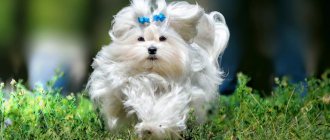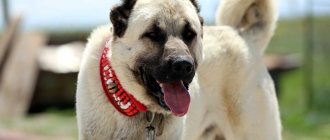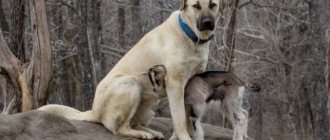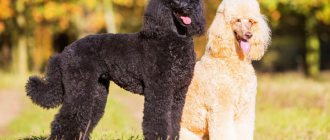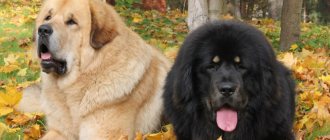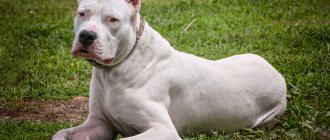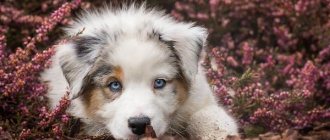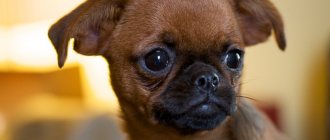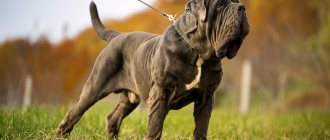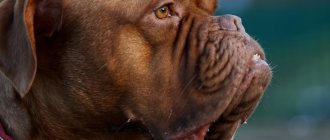Description of the Moscow Watchdog breed
Popularity 46th among 263 dog breeds
Lifespan:
10-12 years
Breed group:
Sentinels
Height:
males: 65-78 cm, females: 70-75 cm
Country of origin:
USSR
Average price:
15-25 thousand rubles
Weight:
males: 55-65 kg, females: 45-55 kg
Latest articles Cat health
Ataxia in cats: what it is, how it manifests itself and is treated 01/23/2022 169 0 0
Cat health
Leukemia, or viral leukemia in cats 01/23/2022 151 0 0
Key facts
Representatives of this breed are quite rare, so they are especially valued by lovers of extraordinary or unique animals. “Muscovites” have obvious security and protective qualities, since in the 40s of the 20th century they were bred by Soviet breeders for service in military structures.
But, despite their fighting blood, they have a balanced character. The description of the Moscow Watchdog breed says that the dogs make excellent family companions and protectors. They are careful with children, but under no circumstances should you leave a child alone with such a large dog.
Sometimes these four-legged friends are stubborn and very naughty. From birth they need strict education and training. It is advisable to have your pet trained by an experienced person. The maintenance will require sufficient costs, since the animal needs two or three times more food than an ordinary medium-sized dog. The characteristics of the Moscow Watchdog breed warns of these nuances.
Shaggy guards calmly endure loneliness. They are unpretentious eaters and can withstand harsh weather conditions. Their health is good, and the life expectancy of the Moscow watchdog is 10-12 years, which is normal for giant breeds.
Interesting Facts
- The dog Orslan is considered the ancestor of the breed. He combined all the desired qualities - endurance, fearlessness, devotion, protective and watchdog instincts. And everyone was satisfied with the appearance. It turned out that he personified the breed standard.
- On the Internet you can find a lot of evidence that an adult Moscow guard dog is an excellent nanny. And indeed, the dog will happily give your child a ride, play with him, and even swim. But you can’t leave children with such a large beast for a long time. He may accidentally wave his tail, or turn around, or step on his paw - and the child will be injured.
- Outwardly calm and slightly indifferent to family disputes, the dog hears and understands perfectly what is happening. He is great at keeping track of who has the last word. Therefore, to avoid further outbursts of disobedience towards anyone, do not quarrel with each other and do not punish children in front of him.
- In the large list of people and animals to whom he treats peacefully, there is one gap - small dogs. He doesn't trust them and doesn't like them.
- A distinctive quality of Muscovites is their manner of security. They do not waste time barking, they attack silently and without warning.
- In old Russia, landowners had Medellian dogs, very similar to modern Moscow guard dogs. They hunted bears, poisoned cattle, and guarded their property. One of the representatives of these dogs was kept by the famous writer A.I. Kuprin, as can be seen in the photo.
The history of the origin of the Moscow watchdog
In the middle of the 20th century, the country needed strong four-legged defenders. In a domestic kennel called “Red Star”, the leadership of the military dog breeding school received a state order to breed dogs with excellent guarding qualities and great endurance. Animals had to withstand harsh climatic conditions, long periods without food, and heavy physical exertion. The base of the nursery was poor in the variety of breeds. Mostly trophy specimens from Germany were kept there. But, despite this fact, Soviet breeders managed to develop four new breeds, including the Moscow Watchdog.
Matings were carried out with Russian piebald hounds, St. Bernards, and East European shepherd dogs. “Muscovites” adopted many character traits from Caucasian Shepherd Dogs. Their family also became involved in breeding the ideal four-legged fighter. The main goal of the breeders was to convey the natural aggression characteristic of Caucasian Shepherd Dogs.
In 1950, Moscow dogs took part in the exhibition for the first time. Joy, Despot, Divny, Don, Dukat and Dido are six littermates who managed to earn special attention from the jury, although they had some defects.
At the end of the 50s, an exterior standard was formed. The official recognition of the breed in the Soviet Union dates back to 1985. International cynological organizations to this day are dubious about “Muscovites”. They are usually found in the CIS countries, the Czech Republic, and Poland, where they are bred by individual breeders, but not by nurseries.
Features of character and behavior
This breed is a service breed and at the moment it has not lost its service qualities . It is rarely recommended as a companion dog, although it is quite friendly to household members. Such a pet will become a thunderstorm for anyone who tries to cross the threshold of a house or the border of a fence. When enraged, the Moscow Watch is truly dangerous.
This dog is not overly aggressive, quite balanced and calm. But she needs to be seriously educated and trained; she will not obey a weak-willed person. It is not recommended for beginners, elderly people or children.
Advantages
Guard dog, protection dog, service dog. The Moscow Watchdog serves in many cities of Russia, in the border troops and police.
- Their physical qualities make it possible to export dogs to the far north, where they are indispensable both in private households and in security services. Such pets never give up and protect their territory and family at the cost of their lives.
- Watchdogs are loyal and affectionate.
- They treat children well and will not react aggressively to them or offend them. But due to its size and mental abilities, you cannot buy such a pet as a gift for a child.
- Calm and unobtrusive, they bark only when necessary.
- You could say that at home these pets are cute, lazy teddy bears who love to spend time with their family.
Flaws
- This breed is very serious and dangerous without proper training. She needs a firm hand, literally and figuratively.
- Dogs weigh a lot, the fragile girl is physically unable to restrain the power of the dog when he tries to break free from the leash.
- Really unfriendly to outsiders. Any unfamiliar person seems like a threat to the Moscow Watchdog: both a child and an adult. Therefore, such a pet must always be kept on a leash and muzzled when walking in crowded places.
- They do not like other animals, especially dogs. They will attack them at every opportunity.
- They can be stubborn and disobedient. Usually they do not strive to take the position of master in the house, but without competent maintenance they will “sit on the neck.”
Appearance of the Moscow watchdog
General impression
The dogs have quite large body sizes, as can be seen in the photo of the Moscow watchdog. Males with an average height (height at the withers) of 65-78 cm weigh about 55-65 kg. Females, having a height of 70-76 cm, weigh approximately 45-55 kg. They are strongly built and have a strong and stable musculoskeletal system. Despite their gigantic size, Moscow watchdogs are very mobile and dexterous. Their relatives are Swiss watchdogs and are even larger.
Head
On a skull that is narrower than that of the “doormen,” the central longitudinal groove is clearly visible. The dogs have a wide forehead and strong massive cheekbones. The brow ridges and the bump on the back of the head are clearly visible. The longitudinal muzzle is represented by a smooth transition from the eyes to the nose.
There are no jowls on black voluminous lips. The large mouth with a scissor bite contains white and sharp teeth (42 pieces). Incisors are on the same line. On the elongated nose there is a round black earlobe. According to the standards of purebred individuals, it should be wide with a black color.
The ears are triangular in shape with a rounded end. Due to the peculiar structure of the cartilage, the ears are in a constantly hanging position so that the edges touch the cheekbone.
Eyes
The eyes are medium-sized, fairly deep-set, with dark drooping eyelids and long, thick eyelashes. As a rule, the iris is dark in color: black, dark gray, brown.
Neck
The muscular neck is of medium length with a mobile, well-developed scruff. Some Moscow watchdogs do not have a dewlap (fold of skin and fat). This feature is not considered a deviation or disadvantage.
Torso
The body of the Moscow watchdog has an elongated rectangular shape. The high withers are clearly pronounced, especially in males. A strong, wide back, like a reliable shield, with a voluminous short loin and a slightly sloping croup. Dogs have a very deep chest. Convex ribs create a strong protective skeleton. Closer to the croup they expand. The stomach is slightly tucked.
Forelegs
Straight legs are placed clearly parallel. The long shoulder blades are slightly slanted, and the muscular shoulders form the base of the supporting part. The paws are round in shape with dense toes and elastic pads. The dewclaw is usually removed at an early age.
Hind limbs
The hind legs are larger than the forelimbs and are presented in the shape of an oval. Strong, massive thighs of equal length to the shins.
Tail
The thick tail is a continuation of the croup line. In the normal state of the animal, the tail is lowered down, there is a small bend at the end. In the opposite excited mood, the tail is raised above the level of the back, curving into a crescent shape.
Movements
Movements are free and measured. Despite their large body size, dogs move easily and have a high reaction speed. With proper upbringing, they are careful when in contact with humans.
“Muscovites” need a fairly wide living space. Thanks to their natural intelligence and ability to behave diligently in a cramped room, they will try not to cause trouble to others, sitting peacefully on the side or next to their owner.
Wool
The abundant coat has a double layer, which consists of guard hair and thick undercoat. Individuals with a dense massive collar or flowing feathers on the back of the legs look very elegant. Bitches usually have sparser coats than males.
Color
There are two types of colors of the Moscow Guard; red-piebald and spotted. The spots can be red, dark red, black, dark gray. The main condition is the presence of a red tint in one variation or another. The chest, lower limbs, and end of the tail should be painted white. A dark or black coat color of the head is considered an advantage.
According to the exterior, it is necessary to have dark spots in the form of glasses on the eyes, as well as black tones of fur on the ears. The most beautiful and graceful pets are those with contrasting colors, that is, with clear lines of transition from color to color.
In general, a variety of colors, hair types, and fur lengths can be found. Animals whose blood is dominated by Caucasian Shepherd roots have fluffier coats with obvious feathering and mane. Also, hair length may vary depending on the season of the year.
Size
The weight of the Moscow Watchdog corresponds to its size: it averages 60 kg for males and 50 kg for females. The height of the Moscow watchdog reaches approximately 75 cm.
Breed standards and character
You can often find two more names for this breed - Muscovite and MS. Therefore, we will use them sometimes. General characteristics: height in boys is up to 68 cm at the withers, in girls - up to 66 cm, weight, respectively, is 55-45 kg. The body is voluminous, with a slightly elongated body, well-developed muscles, and somewhat heavy. All parts are sculpted massively and well.
- The head is large, but in harmony with the body. The forehead is wide, slightly convex and divided in the middle by a furrow. The back of the head is powerful, the stop is noticeable, but short.
- The muzzle is shorter than the rest of the skull, blunt, deep. The lips are fleshy, black in color. The jaws are strong and wide. The teeth are strong, white, scissor bite. The nose is large and black.
- The eyes are round, dark, but lighter than the surrounding fur. The look is confident and calm.
- The ears are triangular, hanging at the tips of the cheekbones.
- The neck is short, oval in cross-section and, of course, pumped up. The scruff is well defined. A slight suspension may be observed.
- The chest is voluminous, the back is straight, the lower back is wide.
- The front legs are straight and parallel, the hind legs are set slightly wider, but also parallel to each other. The paws are oval, the pads are thick.
- The tail smoothly continues the line of the back and is quite thick. Usually hangs down to the hock joint. If the animal is slightly “on edge”, it is raised in the shape of a crescent above the back.
- The movements are perfectly balanced, the dog knows how to control his body.
- The coat is long, thick, with undercoat, shorter on the head and the front of the paws. A slight waviness on the back is acceptable. The color is white-red-black in different proportions.
A textbook version: a dark head with a mask, black glasses and ears, a dazzling white chest, a wide longitudinal stripe of the same color on the muzzle exactly in the middle, and the front surfaces of all paws. All other fur is permanently red. But the colored areas are clearly separated from the white areas by borders with sable coloring.
The standard provides for two color options for the Moscow Watchdog: red-piebald and spotted
Disadvantages of appearance include:
- Neck too long
- Short ponytail with crochet or ringlet
- Narrow head
- Saggy lips
- Strabismus
- Light iris color
- curly wool
- Not symmetrically colored muzzle
- Malocclusion
- Brown eyelobe and eyelids, eyes of different colors
- Nervousness and cowardice.
The main task is to protect the territory allocated for it. The protection of the people living there is a priority. The dog knows no fear, never retreats, but in the family he is sociable, balanced and independent. It is safe and comfortable with him.
The giant's character has a slight stubbornness and desire to dominate, which is why training should be carried out by an experienced mentor. However, the scientists’ calculation that the future guard would inherit the full aggression of the Caucasian did not come true. The Muscovite is much more good-natured, not at all angry or reckless.
The character of the Moscow guard dog is self-sufficient, discipline is in the genes. Therefore, she will never be offended if you left her at home, will cope with loneliness, and will accept almost any conditions, except betrayal.
The Moscow Watchdog becomes strongly attached to its owner and has difficulty withstanding loneliness.
The character of the Moscow watchdog
The MS only partially adopted the aggression of the “Caucasians”. They are distinguished by courage and deep intelligence. Dogs are not the first to start conflicts, but if necessary, they are able to bravely stand up for themselves and for humans. Their behavior is largely due to their blood relationship with real fighting breeds. The character of the Moscow watchdog is determined by its origin.
Four-legged creatures with a predominance of Caucasian genes are usually more suspicious and sometimes ferocious. Without a doubt, they can be called professional security guards. Dogs with a St. Bernard temperament are calm and even phlegmatic. Aggression manifests itself only in extreme circumstances, when the animal sees a clear threat in front of it.
Many owners claim that MS behave very responsibly towards children. But do not forget about hereditary inclinations. They are, first of all, guards with a fighting character. They obediently follow the instructions and commands of all household members, without dividing family members into main and subordinate roles.
Price
The price of a Moscow watchdog depends on the nursery and the availability of documents. A puppy with documents costs approximately 25,000 rubles, a puppy without documents costs 10-15,000. It is advisable to purchase a pet from trusted nurseries with documents. This will guarantee that the dog is a purebred representative of its breed, and not a crossbreed.
You can buy a dog of this breed throughout central Russia, Siberia and other northern regions of our country. If necessary, you can purchase a pet from a service kennel, where qualified guards are trained. There they undergo quality training and training. But the cost of such a dog exceeds 35,000 rubles.
Result:
- This is a good guard for a personal plot, but not for an apartment.
- The dog requires strict training
- It is better not to purchase for a family with small children. Moscow Watchdog is perfect for a middle-aged couple
- With proper maintenance and care, the animal will not suffer from diseases
- The dog needs an active lifestyle
Education and training
From a young age, dogs must clearly understand and accept the authority of their owner. They have a balanced character, quite obedient, but sometimes they can snap. In this case, you should not respond with aggression.
The upbringing and training of a Moscow watchdog should begin with the important command “Come to me!” It should be pronounced firmly and clearly, like an order. Rewarding with a treat when a task is completed is appreciated. After the puppy has approached, give him a treat and then release him with the word “Walk.”
The commands “Fu!”, “Place!” can be pronounced in a more strict intonation. Under no circumstances should you hit your pet. So the puppy will grow up to be a coward or a very embittered beast. If you are going to give your pet a future at an exhibition and competition, you will need to study the lessons “Show your teeth” and “Nearby”.
Dogs with a potential career future need to study the protective guard service (PSS) program. This is not necessary for a furry family pet. Regular home training will be sufficient, before starting which it is recommended to study the habits and character traits of the four-legged creature.
Puppies begin to show their character at six months of age. Teenagers often do not respond to a nickname, growl or begin to rage. The mothers of the puppies themselves use this method: the naughty friend is knocked down and forcibly held on his side for some time until the resistance decreases.
Trainers do the same thing. It is important not to show your fear to the dog. This promises a loss of your authority. You should also not tease or provoke your dog by taking away food or toys.
Looking for a Moscow guard dog? Find your pet from 1 offer Buy
Description and features
The Moscow Watchdog is often confused with the Caucasian Shepherd or St. Bernard. This is no wonder, because both of the above breeds are its progenitors. And the dog inherited many traits from them. However, there are noticeable differences. They differ in coat color from Caucasians, and from St. Bernards in their bone structure, muscles and weight.
If you see a large dog of red and white color, with dark tips of the ears and a mask on the face, especially black around the eyes, you know that this is a Moscow guard dog . She doesn’t look like a big, kind dog; on the contrary, she has an outstanding build, well-developed muscles, powerful paws, a confident gait, and an attentive look - all this characterizes a dog of special training.
A kind of special forces among dogs. The Moscow guard dog in the photo looks like a hero, especially against the background of other animals, objects or people. It is impossible to flirt with her, only negotiate. It seems that in her “dog vocabulary” there is only a set of commands. However, hidden within that big body is a noble heart.
Understanding his status perfectly, the dog never shows excessive aggression; it is difficult to start him off like a “Caucasian” ancestor. He fits in well with the family, loves children and reacts calmly to other animals. An obligatory aspect is education, and it should be dealt with by a professional mentor. Then your home and family will be under reliable protection.
Moscow guard dog is an intelligent and friendly breed of dog.
Health and illness of the Moscow watchdog
The average lifespan of dogs is 10-12 years. Moscow watchdogs generally have good health and enviable endurance. However, such large breeds are characterized by a number of characteristic diseases that are caused by heredity, as well as large body size.
Possible diseases
Thus, Muscovites often suffer from dysplasia of the hip and elbow joints. This disease is characterized by the destruction or complete modification of joint tissue. The cause is usually excess weight. Veterinarians recommend monitoring the dog’s diet, not overfeeding it, and providing it with sufficient physical activity.
Strengthening the muscle frame helps relieve a lot of tension from the joints, performing a compensatory function. Conscientious breeders x-ray their dogs before breeding them further. When buying a puppy, you should ask the seller about the results of such a study or, if possible, see the parents of the fur baby.
Four-legged fighters are susceptible to food or contact allergies. The main thing is to identify the allergen in time and exclude it from the diet. In case of exacerbation, it is better to give an antihistamine. Liver problems can cause allergies. Hepatoprotectors correctly selected by a veterinarian will relieve symptoms.
An excess of calories in the diet and a sedentary lifestyle lead to obesity. Excess weight provokes the occurrence of many diseases. To avoid the described situation, it is important not to overfeed your pet with flour products, fatty meats, and high-calorie foods. The diet must include vegetables, fruits, and fish.
Moscow watchdogs can develop infectious diseases: fungal, bacterial, viral. These include:
- rabies;
- viral enteritis;
- Aujeszky's disease;
- parainfluenza;
- kennel cough.
Some preventive vaccinations are given at a young age or immediately after birth, others must be given every year.
The most common symptoms of an infectious intestinal disease are bowel dysfunction, poor appetite, vomiting, constant craving for water, and lethargy. When infected with rabies or parainfluenza, the animal avoids light and is afraid to drink water. The main carriers of rabies are wild foxes.
If you often travel with your pet out of town or live near forests, try to properly fence off your pet’s habitat, keep a close eye on it and get vaccinations up to date. In many regions of Russia, free vaccination of pets against rabies takes place in the spring.
Protozoa can cause a dangerous disease - coccidiosis. Infection occurs when the coccidia bacterium enters the body through the oral cavity. Carriers are rats, mice, birds. Continuous loose stools are the main symptom. In this situation, you should immediately consult a doctor.
Reproductive health
A delay in the first heat (otherwise known as emptying) in MS is not a rare situation. Normally, it occurs at 6-12 months. This psychophysiological process lasts for 20-25 days with an interval of six months.
The first discharge appears at a stage called proestrus. It lasts about 10 days. From 10 to 16 days during the estrus stage, the bloody discharge changes to clear. This period is the most suitable for fertilization; the female is ready for mating. From 17 to 20-25 days, sexual desire gradually decreases, as does the likelihood of conception.
Walking with a dog in heat should be strictly on a leash, and do not allow males to get close to it. Veterinarians do not recommend using birth control pills, as they have a lot of contraindications and cause side effects. If it is not possible to completely limit the bitch’s contact with the opposite sex, taking such drugs will be a better option than abortion after an unwanted accidental mating. The most suitable age for the first pregnancy and childbirth is from 12 months.
Before the appearance of bloody discharge, juvenile vaginitis may occur - inflammation of the vagina that occurs with purulent discharge. It does not require any treatment and goes away with the onset of estrus. To maintain your dog's hygiene and cleanliness around, you can purchase special diapers. They will need to be removed periodically.
Possible diseases
Despite its large number of advantages, the Moscow Watchdog breed is susceptible to diseases characteristic of its breed. This:
— Hip dysplasia. Occurs when the animal is insufficiently active. It appears at the age of 8-10 years and is difficult to treat. To prevent pathology, it is necessary to provide the dog with the opportunity to actively play and move a lot in the fresh air.
- Obesity. Occurs as a result of improper feeding. Excessive consumption of fatty meat (mainly pork) in the absence of activity leads to the accumulation of fat. This can lead to irreversible changes in internal organs. To prevent obesity, it is advisable to follow a feeding regime and move more with the animal.
- Food allergies. Some individuals are sensitive to certain components of the diet. Manifested by swelling of the eyes and ears, hair loss. With such manifestations, the owner needs to pay more attention to the dog’s nutrition and seek help from a veterinary clinic.
These are the main diseases that Moscow watchdogs suffer from. Other pathologies are possible, but to eliminate them you need to visit a veterinarian.
Features of feeding and diet
It is important not to overfeed your pet. The diet should be formed from the following products:
- lean meat, offal;
- sea fish (navaga, cod);
- porridge from buckwheat, rice, millet, rolled oats;
- vegetables and fruits;
- fermented milk products (cottage cheese, low-fat kefir, yogurt).
It is worth giving preference to premium or super-premium industrial feed.
Vitamins and supplements in capsules will be of great benefit. Vitamin-mineral complexes contain chondroitin and glucosamine necessary for joints and bones. It is advisable to exclude these products:
- mushrooms;
- legumes (beans, peas);
- sweets, flour products;
- small bones;
- River fish;
- spicy, smoked, salted products.
From about two months, puppies begin to be given lightly stewed vegetables, for example, soft pumpkin, cabbage, zucchini, potatoes, beets, tomatoes. A good dressing would be unrefined vegetable oil. Since representatives of the breed often suffer from allergies, each new product should be introduced into the diet in small quantities.
Care and maintenance
The ideal living conditions for such large creatures would be an indoor, warm enclosure with a booth and a soft place. It is advisable that the dog can see the entire surrounding area. Some owners keep dogs in the apartment, but this causes a lot of inconvenience for both the family members themselves and their shaggy friend. MCs adapt well to cold winters thanks to their thick coat. To keep an animal in the house, you will need to allocate a soft bed in a secluded place.
The breed is very fertile, so the female will need an enclosure with plenty of space. If you plan to purposefully engage in breeding, try to additionally build a secluded and spacious place for keeping puppies with a corner for the “maternity hospital”. Caring for and maintaining a Moscow watchdog with its offspring requires large physical and financial costs.
The first thing you should buy with your baby is numerous combs or mittens with spikes. Shedding occurs twice a year and there will be a lot of long hair everywhere. It can be partially removed by daily combing with combs or furminators. From a young age, the puppy should get used to such procedures.
A guard dog should be bathed about 3-4 times a year. More often, water procedures are carried out with household inhabitants. Once a week, a thorough examination of the ears, nose, and eyes is necessary. You can remove dirt, mucus or wax with a simple damp cloth. To prevent conjunctivitis, it is recommended to wipe the eyes with a cotton swab dipped in chamomile decoction, as it has an anti-inflammatory and antimicrobial effect. An infusion of black tea is also suitable.
Nails are usually trimmed once a month. Four-legged creatures that lead active life grind their claws down on their own.
“Muscovites” living at home are walked for about 4 hours, diluting simple walking with outdoor games or training. Shaggy friends with an individual enclosure require approximately 2 hours for a walk with activities. It is unacceptable to keep pets on a leash.
Puppies are allowed to go out for full outdoor walks after completing two mandatory vaccinations. Before reaching the age of one year, four-legged pets should not be subjected to long walks, especially intense training. It is necessary to allow the musculoskeletal system to strengthen.
Tips for choosing a puppy
Seven weeks of age is the best time for a puppy to move from its mother to a new home. It is better to make acquaintance earlier so that the pet gets used to human attention, especially to the image of its future owners. Before choosing a baby, observe the mother's behavior and reactions. By her behavior you can roughly understand what character her offspring will inherit.
Moscow Guard puppies should be medium in size - weighing about 3.5-4.5 kg. Feel free to carefully examine the animal, its belly, paws, eyes.
Key points in training
The Moscow Watchdog is prone to dominance and displaying its character. Obedience can be achieved without harsh methods, showing your superiority. For example, you should not feed your pet until the family has finished eating. Or not allowing the dog to do what he wants. Brute force is no help. This is how you can raise an uncontrollable aggressive dog.
The puppy needs to be accustomed to a daily routine, feeding and walking schedule. In addition, the dog must know its name well and follow basic commands:
- "near";
- "it is forbidden";
- "place";
- "voice";
- "quiet".
Read about how to properly train a dog in the article: “Training a puppy: effective methods from dog handlers, learning commands at home.”
